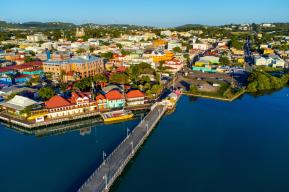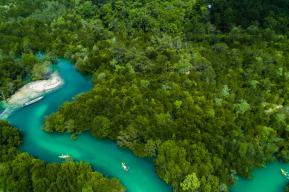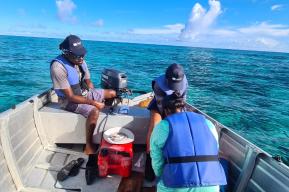News
Manatees, sea turtles and pelicans accompany eDNA Expedition in Belize

A total of 13 fisheries officers and community researchers ventured out to the offshore atolls, coastal lagoons and sand cays that make up the largest barrier reef in the northern hemisphere. The team collected eDNA samples at Bacalar Chico Marine Reserve – an important spawning aggregation site for groupers and snapper, and Glover Reef Marine reserve, South Water Caye Marine Reserve, and Sapodilla Caye Marine Reserve.
The eDNA material was filtered from water samples by community researchers, fisheries biologists, and staff members from the Wildlife Conservation Society, amidst the occasional sighting of species such as manatee, sea turtle, and pelicans. The sampling was facilitated by the Belize Fisheries Department.
The UNESCO eDNA sample method can help us manage the Belize Barrier reef more effectively because it can give very specific information of the species within the area that contribute to the growth and health of the ecosystem.
Environmental DNA is an innovative scientific method that can be used to monitor and evaluate ocean biodiversity without the need to extract organisms from their environment. Just one liter of water may contain genetic material from hundreds of species and may help determine the area’s biodiversity richness.
The UNESCO environmental DNA Expedition initiative is being rolled out across 25 marine World Heritage sites between September 2022 and April 2023. The eDNA data is expected to provide a one-off snapshot of biodiversity richness across marine World Heritage sites, particularly for fish species.
By combining the resulting biodiversity data with Intergovernmental Panel on Climate Change (IPCC) heat scenario projections, the initiative aims to provide a first glimpse of potential geographic and distribution shifts of fish species as a result of climate change which then in turn can inform conservation decision-making.
Resulting data will be available at the UNESCO Ocean Biodiversity Information System, the world’s largest open science marine species database. Final results are expected to be available in Spring 2024.
The UNESCO eDNA initiative is a joint collaboration between the Intergovernmental Oceanographic Commission and the World Heritage Centre. It is made possible with the support of the Government of Flanders (Kingdom of Belgium) and implemented in the context of the United Nations Decade of Ocean Science for Sustainable Development (2021-2030).
About the Belize Barrier Reef Reserve System World Heritage site (Belize)
Once referred to by Charles Darwin ‘as the most remarkable reef in the West Indies’, the Belize Barrier Reef Reserve System (Belize) was inscribed on the World Heritage List in 1996. The property features one of the highest levels of marine biodiversity in the Atlantic, and provides important habitat for the West Indian manatee, various sea turtle species, as well as endemic and migratory birds. The Belize Barrier Reef is famous for its Blue Hole, a unique geological feature resulting from the rise and fall of sea level over the millennia. The spectacular picturesque natural setting of brilliant white sand cayes and verdant green mangrove cayes is in dramatic contrast to the surrounding azure waters.








